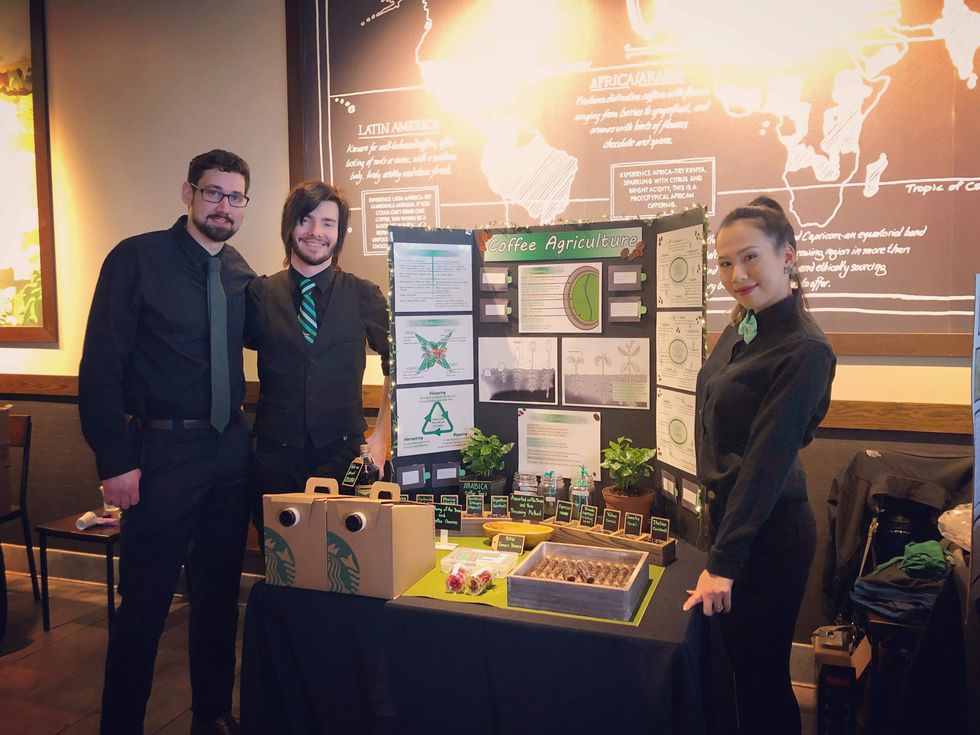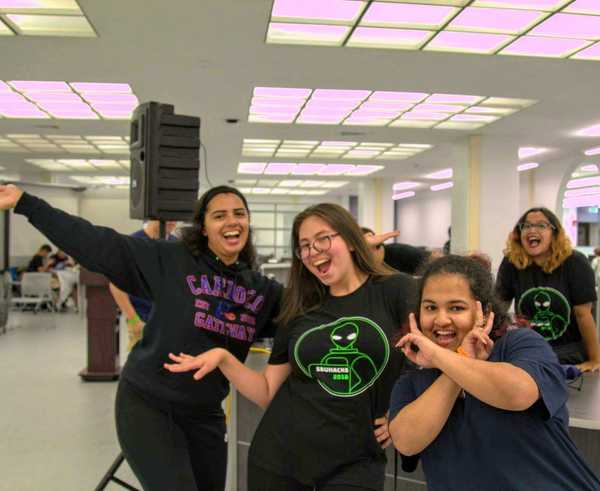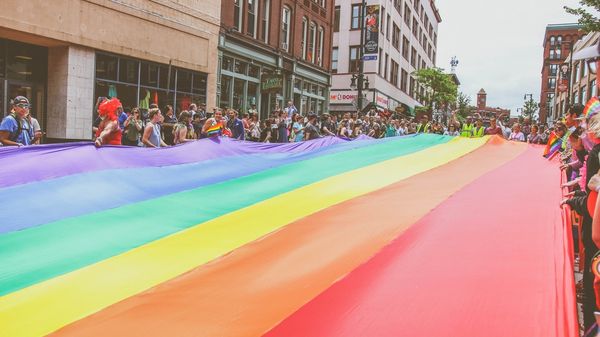Black aprons with names stitched in white over the heart lined the wood counter separating the coffee seminar from the line of caffeine seekers. Starbucks partners dressed in black with green ties mill about setting up poster boards and displays. Some displays have lights and coffee plants made from Play-Doh, others have almond milk ice cream to pair with coffee samples. They stand and chat with customers as they wander over. The store is loud with espresso bars steaming and the influx of people in the Clifton Park store.
Monday, April 18, the Starbucks located on Clifton Park Center Road was bustling with activity. On top of customers looking for a Monday pick-me-up, 16 partners from a variety of local stores were hosting a coffee seminar as the finale of their 12-week Coffee Master program.
A Coffee Master possesses the hotly desired black apron. After training they are versed in the different types of coffees, how they are grown, prepared, and foods that complement them. According to Starbucksmelody.com, before training even begins, the barista must be approved by the store manager. The manager looks for baristas who’ve completed their Coffee Passport, are familiar with drink standards, and have a positive attitude.
The “Coffee Passport and Tasting Guide” is given to all baristas when they are hired. It is a pocket-sized book that lists the four steps to tasting coffee, where Starbucks coffee grows, as well as the different roasts broken down into the sub-groups of being blonde, medium, or dark.
These are three roasts of coffee served at Starbucks. Blonde is a lighter coffee and has less bold flavors; an example is Veranda. The Medium blend at any given Starbucks is Pike Place; the name is a nod back to the first store at the Pike Place Market. Medium blends have rich flavors and medium acidity. Dark roasts, like Anniversary Blend, have bold flavors and tend to be more acidic.
According to the Coffee Passport, the three primary growing locations influence flavor. Latin America produces coffees that are nutty and have a soft spice. Coffees from Africa have a floral or citrus taste. Coffees from Asia and the Pacific are more herbal.
A Coffee Master-in-training does weekly meetings; at the Clifton Park store, which has two baristas and one shift manager in training, it was at 11 a.m. on Mondays where they sampled coffees, and through a video-call discussed the layers of coffee. During the call, they would have to answer questions regarding that week’s reading. The program also included readings and homework outside of work hours. At the end of the program, they take a written test that asks specific questions from the book. The questions include explaining the processing of coffee beans, where the first coffee bean was discovered and the life cycle of the coffee tree. In 2015, there were more than 5,000 active Coffee Masters in stores around the world according to news.starbucks. On Monday, the last group “graduated.”
Rungsirin Maemay Laffey holds up a vial filled with coffee beans. She shows how the vial is made up of four different blends of beans, only noticeable by a slight brown color variation.
Laffey made a profile of a coffee cherry out of Play-Doh, taking time to label all parts of the cherry from the outer skin, pulp and the mucilage, which are the layers around the actual coffee bean, in different colors of dough.
Laffey and her team members Brandon Jones and Nathan Holly, natives of the Clifton Park store, presented on Coffee Agriculture. Diagrams showed the three types of washing processes beans could go through; from washed, semi-washed, and natural processing. Washed coffees have a higher acidity from fermenting in a big tank like Guatemala Antigua. Semi-washed is lightly rinsed and dried twice. This process yields coffees such as Sumatra or Kenya. The Natural Process coffees are grown in areas that get more rain, so they are often dried more and produce Sun Dried Ethiopian coffee.
There is no pay increase with becoming a Coffee Master, but that doesn't bother Laffey. She says the pay off is the pride. "Anything I have achieved will be put on my resume and another story to tell to my son when he grows up. Also if my co-workers or customers ask me about coffee, I can answer that for them," she said.
For Laffey, the process yielded other difficulties such as having to translate the Coffee Master manual into Thai, her native language. She had to focus on making sure critical words translated. Laffey also found herself unexpectedly studying Coffee-Master readings in the ER. "We can’t miss one, if you miss one you don't finish," she said.
Her favorite roast is Blonde Espresso. While Laffey doesn't enjoy coffee, she found the Blonde to be easy to drink. It was creamy and tasty without flavoring.
Holly has his eyes on one of the Arabica trees the group bought for the project. Holly said there are two types of coffee, Arabica and Robusta. Arabica has more complex flavors and grows near volcanoes. Robusta doesn't mean robust in flavor but a bigger bean. "Arabica is the premium bean,” he said.
From four main Arabica trees, Bourbon, Typica, Caturra, and Catuai, come thousands of other trees. These trees flower after nine months, and the longer the bean is on the tree, the more the flavor develops. According to Holly, if the coffee cherry falls off the tree, it is considered an "inferior bean."
With a love of learning, he wanted to become a Coffee Master as soon as he heard about it. "I saw the black apron, and I wanted the black apron," he said with a laugh.
Jones has been working with Starbucks since 2016 and transferred to the Clifton Park store a few months ago. With high energy and a car with bat wings, he is hard to miss. Jones feels like he has accomplished something significant and thought it would benefit not only him, but the partners around him. “I would see Coffee Masters; it all felt so far away and on an unobtainable level at first. I learned that it’s truly a desire to want to learn more about what we love and why we love it,” he said.
After the first year, the coffee plant is transported to a farm and will develop for three to five years; after, it will yield a harvest every nine to 12 months. The trees can grow up to 30 feet tall but are kept to five to six feet. Trees closer to the equator can yield two harvests a year. Often these cherries are picked by hand.
Jones’ favorite coffees include Café Verona and Sumatra due to their herbal taste and low acidity.
Clifton Park Store Manager mills about the store talking with the new Coffee Masters. She has been a Coffee Master for six years and says the information hasn’t changed but evolved. The manager said this is the last group of Coffee Masters unless the program is revamped. “I think they are just focusing on other things and maybe making it better for when they do it again, but as far as Coffee Masters and the black aprons, right now this is the last group,” she said.
Coffee was first discovered in Ethiopia in 1000 A.D. by Kaldi and his “dancing goats” that had eaten the coffee cherry and were so caffeinated they "danced." Kaldi then boiled the cherry in water and drank it. Sarah Angilletta-Greive and Cody Porter, baristas from the Niskayuna, NY store, did their project on the history of coffee. Grieve said that in 1450, under Turkish law, women had a legal right to divorce their husbands if they didn’t provide enough coffee. She laughed and seemed to think it was a good idea. Grieve also said that coffee spread into Brazil because a Brazilin Lieutenant went into Guyana and had an affair with the governor's wife and as a parting gift she gave him a bouquet of flowers which concealed coffee seeds. “Pretty much that’s the father of all the coffee plants in Brazil, to this day, which is pretty interesting, they would have never gotten there if it wasn’t for this little affair,” she said.
In their studies, they learned that before the introduction of Blonde Roast in 2012, the coffee was roasted 80 times before they decided on the perfect roast. No other roast has gone through this.
“We’re in Niskayuna, it's a very community-oriented environment, and we have a lot of coffee drinkers, a lot of people who meet there in the morning, and we felt like we wanted to know more about coffee to be able to share with our customers. Honestly, that's the main reason we want to do this. You don't want to sound like an idiot when talking to your customers," she said.



















